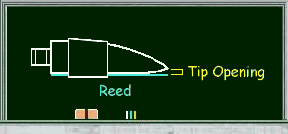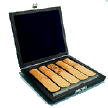For woodwind instruments with reeds such as clarinets, saxophones, oboes, and bassoons, please be sure to explain the reeds thoroughly before you begin practicing.
In order to maintain the condition of the reed, students must fully understand how to handle it, otherwise they may continue playing a damaged reed without worrying about it.
There seem to be various misunderstandings about how to choose and use clarinet and saxophone reeds.
First of all, I think that many teachers choose reeds that are too thin, thinking that thin reeds are easier to sound. On the other hand, in junior high schools and other places, I often see students assuming that those who play with thicker reeds are skilled players, and forcing themselves to use reeds that are too thick to allow for light tonguing. No matter how thick the sound is, a reed that cannot control the articulation is meaningless.
The thickness of the reed is determined to some extent by the opening at the tip of the mouthpiece (see below).

If the reed is too thin or too thick beyond that range, there will be various problems in terms of pitch, tone, and articulation.
The size of the mouthpiece opening is also a major factor in determining the characteristics of the mouthpiece. For example, the wider the opening, the more volume you can change, but the more difficult it is to control the sound. If there is something good about it, there will always be some problems.
Therefore, at first, choose a mouthpiece that is moderate in various aspects, and think about which reed is best suited to this student within the tolerance range of that mouthpiece.
Even if the reeds are the same thickness according to the standard, some are easy to sound and some are not. This is thought to be due to the variation in density of the cane fibers, and slight differences in thickness between the left and right sides when carving.
If students can play to a certain level, they can play all the reeds and choose the best ones from among them, but in the case of elementary school, this can be difficult due to budget constraints.
However, especially in the case of clarinet or alto sax, do not give the player just one reed and let them play until it is worn out, then change to a new reed. There are still some junior high schools that do this. In that case, students will never know whether their reed is good or bad, and the condition of the reed will change during a day of practice, making their embouchure unstable.
In order to always use reeds in a consistent condition (to create a stable embouchure), get into the habit of changing reeds at regular intervals (20 to 30 minutes). If students practice for 40 minutes to an hour a day, prepare 2 or 3 reeds. If students practice longer than that, they can use 3 or 4 reeds in order. For this reason, it is better to prepare a reed case if possible.
 By changing several reeds in sequence, you can always maintain a certain level of resistance. Replace the reeds that have become worse with new ones.
By changing several reeds in sequence, you can always maintain a certain level of resistance. Replace the reeds that have become worse with new ones. Although students will need more reeds at first, each reed will last longer because they can replace them in a short time.
Some people believe it is important to teach children from the beginning that reeds are natural products and therefore each one is different.
However, I wonder if it is a good idea to add another burden to elementary school students who are just holding an instrument for the first time, learning how to assemble a clarinet, learning the fingers... by using a reed that does not sound.
For many teachers, when a student is having trouble producing sound on a reed instrument, it is difficult to know whether the problem is due to the way the student is playing, whether the instrument is poorly tuned, or whether the reed is to blame.
There are some synthetic reeds on the market these days that are fully usable. They are not affected by humidity and are of consistent quality.
Over the past few years, we have tried reeds from Canadian and American manufacturers at several junior high schools, and I felt that it would be fully usable for normal elementary and junior high school ensembles. Some teachers said that they were not bothered by the sound quality, or rather, that they couldn't tell the difference depending on the range and volume. Why not try these reeds?
If you handle it with care, you can use one for years, and the versions for baritone saxophone and bass clarinet are roughly the same price as the Bb clarinet, so it's worth trying out for that reason as well.